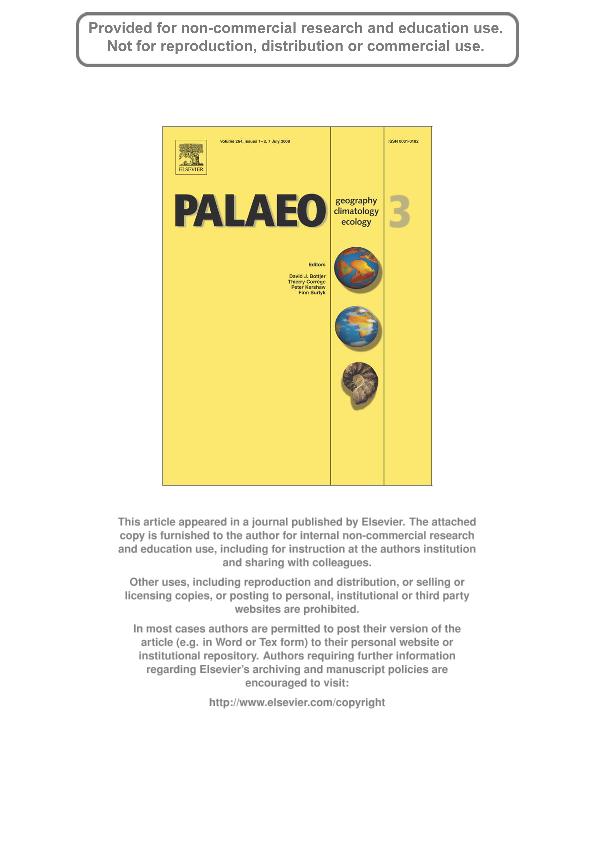Mostrar el registro sencillo del ítem
dc.contributor.author
Genise, Jorge Fernando

dc.contributor.author
Bedatou, Emilio

dc.contributor.author
Melchor, Ricardo Nestor

dc.date.available
2019-08-14T22:17:24Z
dc.date.issued
2008-07
dc.identifier.citation
Genise, Jorge Fernando; Bedatou, Emilio; Melchor, Ricardo Nestor; Terrestrial crustacean breeding trace fossils from the Cretaceous of Patagonia (Argentina): Palaeobiological and evolutionary significance; Elsevier Science; Palaeogeography, Palaeoclimatology, Palaeoecology; 264; 1-2; 7-2008; 128-139
dc.identifier.issn
0031-0182
dc.identifier.uri
http://hdl.handle.net/11336/81630
dc.description.abstract
The breeding trace fossils described herein along with the high density of Loloichnus baqueroensis in the Cretaceous formations of Patagonia suggest that crayfishes were soil engineers along the Cretaceous in southern South America, and that they had acquired many of the K-breeding behaviours recorded by insects in latest and post-Cretaceous soils, such as pelletal constructions and excavation of breeding cells. The K-T event was probably responsible for changes in environmental conditions in such a way that crayfishes finally became restricted to two small distributional areas in southern South America, and K-breeding insects replaced them as keystone organisms in Cainozoic and modern soils. Dagnichnus titoi igen. and isp. nov. and Cellicalichnus meniscatus isp. nov., are created to include the new trace fossils attributable to crayfishes from the Cretaceous of Patagonia, Argentina. The attribution to crayfishes is based on their association and morphological affinities with the crayfish fossil burrows L. baqueroensis from the same geologic units. D. titoi is represented by hemispherical chambers surrounded by thick and short, meniscate burrows, which can be arranged in two or three tight whorls in the more regular specimens. Meniscate burrows are curved downwards and have no neck. Walls are unlined. C. meniscatus are necked, horizontal, and straight cells, showing meniscate fillings, attached to sub-vertical shafts, which are relatively much wider than the neck of cells. Both, shafts and cells show a thin and smooth lining. The presence of cells or burrows smaller than the putative parental burrows and comparisons with breeding traces of marine Decapoda support the interpretation of breeding traces, Calichnia, of terrestrial crustaceans. C. meniscatus is interpreted as cells excavated from parental burrows, whereas D. titoi are probably breeding structures completely produced in a different palaeoenvironment where the female release juveniles.
dc.format
application/pdf
dc.language.iso
eng
dc.publisher
Elsevier Science

dc.rights
info:eu-repo/semantics/openAccess
dc.rights.uri
https://creativecommons.org/licenses/by-nc-sa/2.5/ar/
dc.subject
Cretaceous
dc.subject
Evolution
dc.subject
Palaeobiology
dc.subject
Patagonia
dc.subject
Terrestrial Crustaceans Breeding Structures
dc.subject
Trace Fossils
dc.subject.classification
Paleontología

dc.subject.classification
Ciencias de la Tierra y relacionadas con el Medio Ambiente

dc.subject.classification
CIENCIAS NATURALES Y EXACTAS

dc.title
Terrestrial crustacean breeding trace fossils from the Cretaceous of Patagonia (Argentina): Palaeobiological and evolutionary significance
dc.type
info:eu-repo/semantics/article
dc.type
info:ar-repo/semantics/artículo
dc.type
info:eu-repo/semantics/publishedVersion
dc.date.updated
2019-08-14T20:08:27Z
dc.journal.volume
264
dc.journal.number
1-2
dc.journal.pagination
128-139
dc.journal.pais
Países Bajos

dc.journal.ciudad
Amsterdam
dc.description.fil
Fil: Genise, Jorge Fernando. Consejo Nacional de Investigaciones Científicas y Técnicas; Argentina. Museo Paleontológico Egidio Feruglio; Argentina
dc.description.fil
Fil: Bedatou, Emilio. Consejo Nacional de Investigaciones Científicas y Técnicas. Instituto de Ciencias de la Tierra y Ambientales de La Pampa. Universidad Nacional de La Pampa. Facultad de Ciencias Exactas y Naturales. Instituto de Ciencias de la Tierra y Ambientales de La Pampa; Argentina
dc.description.fil
Fil: Melchor, Ricardo Nestor. Consejo Nacional de Investigaciones Científicas y Técnicas. Instituto de Ciencias de la Tierra y Ambientales de La Pampa. Universidad Nacional de La Pampa. Facultad de Ciencias Exactas y Naturales. Instituto de Ciencias de la Tierra y Ambientales de La Pampa; Argentina
dc.journal.title
Palaeogeography, Palaeoclimatology, Palaeoecology

dc.relation.alternativeid
info:eu-repo/semantics/altIdentifier/url/https://www.sciencedirect.com/science/article/pii/S0031018208002125
dc.relation.alternativeid
info:eu-repo/semantics/altIdentifier/doi/https://doi.org/10.1016/j.palaeo.2008.04.004
Archivos asociados
